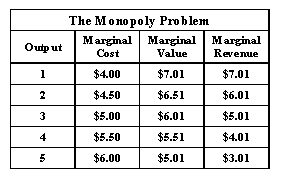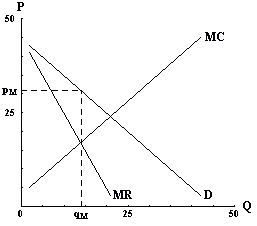|
|
|
A monopolist is the only producer in its industry. Local utilities
are a typical example. Since the monopoly is the only seller, the
downward sloping industry demand curve is the monopolist's own demand
curve. So to sell more the monopolist must lower its price for
subsequent units. In contrast, in a perfectly competitive industry
the price doesn't change as a seller increases its output, so price
is equal to marginal revenue.
|
|
The table below illustrates this. Marginal cost is the value of the
additional resources needed to produce another unit of output. The
marginal benefit to consumers is the price that consumers are willing
to pay for each unit. This is the consumer?s demand schedule. The
economically efficient amount to produce is four, because the fourth
unit is the last one for which the unit cost to the seller is less
than the unit value of the buyer.
|

|
|
From the monopolist?s point of view though it is more profitable to produce only three units because it does not see marginal benefit the same way that buyers see it. Notice that for the seller, the extra benefit of the second unit is only $6.01. It sells the second unit for $6.51, but to sell the second unit, it had to reduce the price it charged by $.50. The
price reduction from $7.01 to $6.51 reduced the revenue from the first
unit by $0.50, so the net increase in its revenue was only $6.01. In a
similar manner, the rest of the fourth column can be obtained.
|
|
Producing beyond the third unit is not in the interest of the
monopolist. The marginal revenue of the fourth unit is only $4.01,
but it costs $5.50. For market efficiency, however, the fourth unit
should be produced. It brings them added benefits of $5.51 and uses
resources worth only $5.50.
|
|
Graphical Representation of Monopoly
The discussion above is illustrated below. The seller chooses output
qM so that marginal cost and marginal revenue are equal.
Market efficiency though occurs when output is where demand equals
marginal cost (D = MC). The monopolist restricts output because of
a divergence between marginal benefit as the firm perceives it and
marginal benefit as buyers perceive it. Producing beyond qM
is not in the interest of the firm because the extra benefit it sees,
marginal revenue, is less than the extra cost of production, shown by
the marginal cost curve. Extra output is in the interest of buyers
because the extra benefit they get, shown by the demand curve, is
greater than the extra cost of production.
|

|
|
Suppose the monopolist faces the following industry inverse demand
curve p = D-1(q) = 45 - q. Then the monopolist's
revenue is R(Q) = p × q = (45 - q) × q. The marginal revenue is
the derivative of this function, which is
MR(q) = 45 - 2 × q.
Suppose the marginal cost curve is p = MC(q) = 3 + q.
Then the monopolist wants to choose the output q that equates
marginal revenue and marginal cost, which is when
MR(q) = 45 - 2 × q = 3 + q = MC(q). So qM = 14.
|
|
The left hand side gives the marginal revenue from producing an extra unit of output. The right hand side gives the marginal cost
of producing an extra unit of output. The monopolist produces at a quantity level where the marginal revenue equals the marginal
cost.
|
|
Experiments on the monopoly model are included in MarketLink for both
the double auction and the posted offer auction. If you haven't yet
used MarketLink to run an experiment, go to the
MarketLink page for information. If you are familiar with
MarketLink, you can add these experiments to you profile from the
monopoly market experiment configurations page.
|
|
Return to the IO index.
|
| |